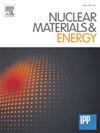氘等离子体实验后LHD粉尘氚保留特性
IF 2.7
2区 物理与天体物理
Q1 NUCLEAR SCIENCE & TECHNOLOGY
引用次数: 0
摘要
采用增强型全燃烧法(EFCM)评价了在大螺旋装置(LHD)进行第21次氘(DD)等离子体实验后收集的10个环面粉尘颗粒的氚(T)保留率,并利用氚成像板技术(TIPT)结合扫描电子显微镜(SEM-EDS)对其进行了表征。一种新的固定和储存含T粉尘颗粒的方法,称为导电树脂表面包埋法(eREM),成功地证明了单个粉尘颗粒的T保留特性。从EFCM的结果来看,在第21次运动后,从LHD的所有环形截面收集的尘埃颗粒中的总T保留量为数百MBq。在开放螺旋导流器的环形截面上,片状碳尘颗粒的T滞留量明显高于其他封闭螺旋导流器截面。w涂层C导流瓦断面粉尘颗粒中T的滞留量低于其他C导流瓦断面。Zr-Ti-V粉尘颗粒来源于容器吸气泵材料,颗粒中的T保留率远低于C粉尘颗粒。TIPT结合SEM-EDS的结果表明,不是所有的粉尘颗粒都保留了T,而是有一半的粉尘颗粒保留了T,因此粉尘颗粒的T保留特征可以归因于导致粉尘颗粒产生和输送的粉尘源的T保留特征,另一个原因是T在单个粉尘颗粒中厚度大于T β-电子逸出范围的深度分布。本文章由计算机程序翻译,如有差异,请以英文原文为准。
Tritium retention characteristics of the dust in LHD after the deuterium plasma experiment
Tritium (T) retention of the dust particles collected at ten toroidal sections of the Large Helical Device (LHD) after the 21st experimental campaign, in which deuterium (DD) plasma experiments were conducted, were evaluated by an enhanced full combustion method (EFCM), and their individual T retention was characterized by a tritium imaging plate technique (TIPT) in combination with a scanning electron microscopy (SEM-EDS). A new method of fixation and storage of the dust particles containing T, called the electroconductive Resin surface Embedding Method (eREM), was successfully demonstrated for T retention characterization of the individual dust particles.
From the EFCM results, total T retention in dust particles collected from all toroidal sections of LHD after the 21st campaign was found to be several hundred MBq. Much higher T retention was found in the flaky C dust particles at the toroidal section with the open helical divertor than in the other closed helical divertor sections. T retention in dust particles at the section of W-coated C divertor tiles was lower than at the other sections of C divertor tiles. Zr-Ti-V dust particles originating from in to vessel getter pump materials were found, and T retention in the particles was much lower than in C dust particles.
The results from TIPT in combination with SEM-EDS indicated not all the dust particles but a half of the dust particles retained T. Such the T retention characteristics of the dust particles could be attributed to T retention characteristics of the dust source resulting in the dust particles produced and transported, and the other is depth distribution of T in the individual dust particle thicker than T β-electron escaping range.
求助全文
通过发布文献求助,成功后即可免费获取论文全文。
去求助
来源期刊

Nuclear Materials and Energy
Materials Science-Materials Science (miscellaneous)
CiteScore
3.70
自引率
15.40%
发文量
175
审稿时长
20 weeks
期刊介绍:
The open-access journal Nuclear Materials and Energy is devoted to the growing field of research for material application in the production of nuclear energy. Nuclear Materials and Energy publishes original research articles of up to 6 pages in length.
 求助内容:
求助内容: 应助结果提醒方式:
应助结果提醒方式:


